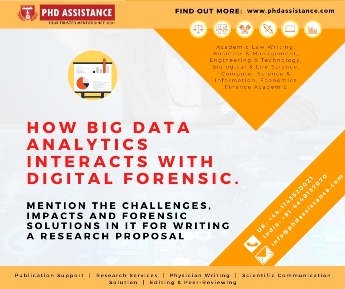Brief:
- The time of Big Data opens new open doors in different fields. While the accessibility of a significant dataset can be useful in certain situations, it presents new difficulties in advanced criminology examinations.
- The current apparatuses and foundations can’t meet the typical reaction time when we explore a significant dataset. Forensic sciences examiners will confront difficulties while distinguishing essential bits of proof from a primary dataset and gathering and breaking down those proof.
- In this PhD Assistance Blog, we explain the big data interaction with forensics and explore the challenges in this forensics paradigm using PhD dissertation on Big Data Analytics for writing a proposal in PhD Projects in Big Data

Introducing big data in digital forensics:
Big data is a popular expression in the IT business and connects with individual information gathered by massive and medium scale undertakings. The term depicts the enormous scope obtaining of information through different sorts of frameworks during PhD Guidance in Big Data Help. The vast amounts of data are frequently utilized, for example, acknowledgement and prescient social frameworks. There is a typical confusion about extensive information in that it is often erroneously connected with the encroachment of individual security. Indeed, proper investigation of organized, semi-and unstructured details will improve the unique experience of the client, to anticipate valuable practices and possibly assist settle on with stinging business choices. Even though the utilization of enormous information examination is underutilized, it is discovering its way into computerized and portable crime scene investigation. The situation of the information is seized or examined antiquities in semi-organized structure, generally in application information bases. It could likewise be found as unstructured information when reading officials get a computerized preview from the capacity chipsets on cell phones, PCs or some other electronic gadgets with advanced capacity. The gathered information is then relocated to workers with practically nothing, assuming any, knowledge handling upon fruitful extraction for PhD Big Data Analytics Specialization.
The four fundamental mainstays of considerable information are of four classes of V, and they are volume (a measure of data), Variety (various kinds of data), Velocity (speed of information preparing) and Value (esteem) in PhD Big Data Analytics
The four mainstays of huge information could be rehashed corresponding to computerized legal sciences in the accompanying manner:
- Volume is a frequent application to refer the measure of information gathered from an individual or various held onto gadgets.
- Variety, to reference the various sorts of records or information present inside the vehicle (for instance this could be assigned information from known document frameworks and unallocated information from volume and record slack spaces).
- Velocity is worried about the measure of time expected to handle the gained information and without a doubt, the time frequently expected to procure the lead at first.
- Value is the estimation of the information. It isn’t the resale esteem, yet the assessment of the genuine knowledge gathered when there is reasonable data accuracy used for PhD Guidance Required Big Data
Challenges for big data in digital forensics:
There is no conventional edge for the size of information that can be alluded to as “large information.” Its grouping is substantially more mind-boggling than a number. The ever-changing size of data is the thing that can be named considerable knowledge. It leaves plenty of new data that could be prepared by law implementation offices to illuminate wrongdoing readily in PhD Data Analytics & Big Data Services
Organized versus unstructured information handling
When examining organized information, it typically alludes to information that has a characterized known structure. It could be numbers, dates, gatherings of words. Strings got to inside the capacity medium. It is information routinely took advantage of during an examination and for the most part, put away in data set records.
Unstructured information will be data that either doesn’t have a pre-characterized information model or can’t no organization in a precise manner, (for example, in requested lines and segments as found in data sets). Unstructured information can remember text for all structures, messages, video, sound documents, website pages and web-based media. Sorting out unstructured information is regularly done by executing complex inquiry questions to concentrate and present all the information in a fine introduced structure. The inquiry questions will empower an inspector to discover information in with a similar relevant system as the examination for writing a PhD Research Topics in Big Data Analytics
Insight expectation
An organized knowledge extraction measure is utilized to inspect the Information and Present the Analyst with a significant dataset to create detailed insight from colossal information. The activities actualized are generally finished in stages. The fundamental point of these stages is to put organized, unstructured and semi-organized information in an unmistakable arrangement that takes after the proof inspected. It is seen that a great extent of law authorization offices doesn’t handle their put away information for real knowledge that can later be utilized in conduct examination, probability of re-culpable or automated profiling.
Forensic solutions:
Preparing
A vital component of using huge information is to see how to deal with the information it contains, and the best strategy for understanding the data is by applying analytical and extraction procedures. MSAB offers information investigation instructional classes which can be utilized to capitalize on information living inside organized and unstructured data and to furnish computerized legal analysts with the aptitudes they have to comprehend and use what they are seeing.
Environment approach
Biological systems are routinely used to empower the handling lifecycle of enormous information. These frameworks would commonly begin with recognizing the media containing the information, distinguishing the extraction profile required for each kind and handling the data once the extraction is finished. The handling procedures will guarantee that organized and unstructured data are filed and sorted. What’s, an endless supply of this cycle, the development ordering cycles will run inquiries that make enormous information substantially more adequate to inspectors during the examination.
Functional application
Analysts worried about the proper handling of extensive information should join modified seller arrangements, nonpartisan merchant programming and their extraction information to guarantee processing arrangements are heterogeneous, augmenting the outcomes they can see.
Conclusion:
Big data examination can give massive focal points to legal analysts, particularly when the substance is handled effectively. The analyst would, for the most part, use progressed search strategies incorporated with the product to address only things inside messages or search history. These methods and more are combined with the securing programming to introduce moment results to an inspector when they look for names, telephone numbers or information strings. Notwithstanding putting away the information and removing explicit datasets, scientific analysts are passing up a great opportunity by not using the capability of the knowledge examination. PhD Assistance helps the PhD Program Big Data Analytics students to write a research proposal.
References:
- Guarino, A. (2013). Digital forensics as a big data challenge. In ISSE 2013, securing electronic business processes (pp. 197-203). Springer Vieweg, Wiesbaden.
- Zawoad, S., & Hasan, R. (2015, August). Digital forensics in the age of big data: Challenges, approaches, and opportunities. In 2015 IEEE 17th International Conference on High Performance Computing and Communications, 2015 IEEE 7th International Symposium on Cyberspace Safety and Security, and 2015 IEEE 12th International Conference on Embedded Software and Systems (pp. 1320-1325). IEEE.
- How to develop mathematical theorems based on literature survey for PhD thesis? - December 28, 2020
- How big data analytics interacts with digital forensics. Mention the challenges, impacts and forensic solutions in it for writing a research proposal - November 24, 2020
- Explain the factors affecting the choice of title for PhD dissertation? - August 29, 2020

